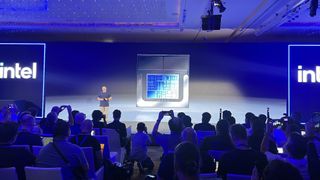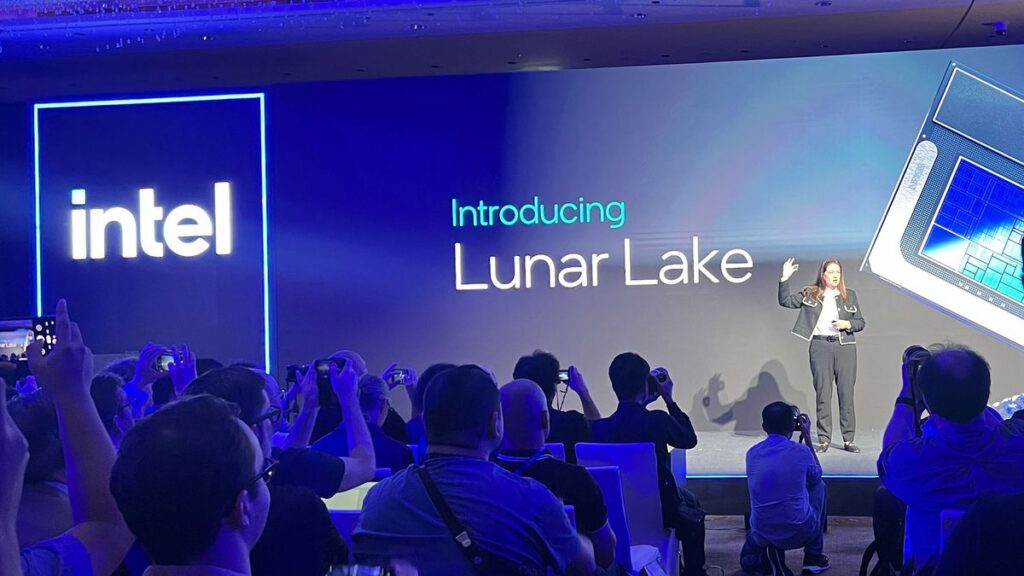Intel lifted the curtain on its latest processor series, codenamed Lunar Lake, during Intel CEO Pat Gelsinger’s Computex 2024 keynote. The new chip will be launched later this year, powering thin and light laptops in time for the 2024 holiday season.
The new system-on-a-chip (SoC) introduces a number of innovations over the current-gen Meteor Lake SoCs like the Intel Core and Core Ultra processors, with Intel claiming better power efficiency, a 4x increase in NPU processing power, a 50% faster Intel Arc GPU based on its next-gen Arc Battlemage architecture, and on-chip memory for a smaller footprint and faster memory access.
Lunar Lake is also the first Intel chip series to meet the minimum requirements for Microsoft’s Copilot+ PC standards, including greater than 40 trillion operations per second for its NPU (TOPS), and 16GB memory.
The new SoC features a highly revamped architecture that introduces a smorgasbord of small changes to how its processors function that collectively achieve significant performance improvements while not using any more power than current Intel Core Ultra chips, and can reportedly get the same performance as Intel Meteor Lake chips with a third of the power, considerably enhancing the potential battery life of laptops equipped with the new chips.
I haven’t tested any of these claims myself, so they should all be taken with a grain of salt until reviewers are able to get their hands on new laptops with Lunar Lake chips in them, but in an extended tech tour ahead of the Computex 2024 announcement, Intel engineers presented a fairly thorough walkthrough of the changes that Lunar Lake will introduce and they are fairly far-reaching, even if individual changes don’t move the needle a whole lot on their own.
New core architectures introduced

(Image credit: Future / John Loeffler)
The biggest innovation in Lunar Lake is the introduction of new hybrid core architecture with Lion Cove performance cores and Skymont efficiency cores. These cores are a major driver of the improved power efficiency that Intel is claiming for Lunar Lake, with a number of small changes to the way instructions are processed by the CPU, the introduction of a new layer of cache memory, and a doubling of the number of efficiency cores over Meteor Lake.
Another major change is the loss of hyperthreading capability. This is when a processing core is able to carry out two instructions per clock cycle rather than one, though Intel says that the optimization that has gone into Lunar Lake’s Lion Cove performance cores more than makes up for the loss of hyperthreading, which comes with its own processing overhead.
{ window.reliablePageLoad.then(() => { var componentContainer = document.querySelector(“#slice-container-newsletterForm-articleInbodyContent-zGr8amZrsg8aCxaDJf3fdT”); if (componentContainer) { var data = {“layout”:”inbodyContent”,”header”:”Get daily insight, inspiration and deals in your inbox”,”tagline”:”Sign up for breaking news, reviews, opinion, top tech deals, and more.”,”formFooterText”:”By submitting your information you agree to the Terms & Conditions and Privacy Policy and are aged 16 or over.”,”successMessage”:{“body”:”Thank you for signing up. You will receive a confirmation email shortly.”},”failureMessage”:”There was a problem. Please refresh the page and try again.”,”method”:”POST”,”inputs”:[{“type”:”hidden”,”name”:”NAME”},{“type”:”email”,”name”:”MAIL”,”placeholder”:”Your Email Address”,”required”:true},{“type”:”hidden”,”name”:”NEWSLETTER_CODE”,”value”:”XTR-D”},{“type”:”hidden”,”name”:”LANG”,”value”:”EN”},{“type”:”hidden”,”name”:”SOURCE”,”value”:”60″},{“type”:”hidden”,”name”:”COUNTRY”},{“type”:”checkbox”,”name”:”CONTACT_OTHER_BRANDS”,”label”:{“text”:”Contact me with news and offers from other Future brands”}},{“type”:”checkbox”,”name”:”CONTACT_PARTNERS”,”label”:{“text”:”Receive email from us on behalf of our trusted partners or sponsors”}},{“type”:”submit”,”value”:”Sign me up”,”required”:true}],”endpoint”:”https://newsletter-subscribe.futureplc.com/v2/submission/submit”,”analytics”:[{“analyticsType”:”widgetViewed”}],”ariaLabels”:{}}; var triggerHydrate = function() { window.sliceComponents.newsletterForm.hydrate(data, componentContainer); } if (window.lazyObserveElement) { window.lazyObserveElement(componentContainer, triggerHydrate); } else { triggerHydrate(); } } }).catch(err => console.error(‘%c FTE ‘,’background: #9306F9; color: #ffffff’,’Hydration Script has failed for newsletterForm-articleInbodyContent-zGr8amZrsg8aCxaDJf3fdT Slice’, err)); }).catch(err => console.error(‘%c FTE ‘,’background: #9306F9; color: #ffffff’,’Externals script failed to load’, err)); ]]>
Sign up for breaking news, reviews, opinion, top tech deals, and more.
All of these changes, taken together, add up to efficiency cores that Intel says deliver the same performance as the current-gen Meteor Lake chips for a third of the power, and up to four times the performance at peak power thanks to the addition of two more efficiency cores. On the performance core side, Intel says Lunar Lake’s Lion Cove performance cores are able to get 50% better performance for the same power as Meteor Lake’s Redwood Cove cores in single-threaded performance, and about 5% better performance with a single-threaded Lion Cove core than Meteor Lake’s multi-threaded performance cores.
What’s more, Intel says that its efficiency cores are mature enough that they can handle more demanding tasks than previous generations of efficiency cores, meaning that workloads that were previously assigned to higher-powered performance cores can now be assigned to lower-powered efficiency cores, increasing the chip’s overall efficiency which should help extend a Lunar Lake-equipped laptop’s battery life to be competitive with Arm-based laptops like those powered by Qualcomm’s new Snapdragon X and Apple’s M3 and M4 chips.
Expanded NPU and next-generation Intel Arc graphics
Other notable advances come from the other two major components of the Lunar Lake SoC, namely the Intel NPU 4 neural processor and Intel Xe2 graphics architecture, based on Intel Arc Battlemage.
Starting with the GPU, the next-gen Arc graphics comes with 8 Xe execution cores, 8 ray tracing cores, a dedicated matrix AI engine capable of 67 TOPS, and promises up to 50% better graphics performance over Meteor Lake’s Arc Alchemist-based architecture.
The NPU, meanwhile, quadruples the performance of Intel Meteor Lake’s NPU 3 neural processor, jumping from 12 TOPS to 48 TOPS thanks to four additional neural processing cores and other architectural refinements.
For those who are counting, this adds up to a total platform TOPS of 120 between the GPU, NPU, and CPU, and when Lunar Lake laptops roll out in Q3 and Q4 of this year, Windows Copilot+ Runtime and other developer APIs will allow app makers to leverage all three processors as needed to better optimize AI tasks.
Whether Intel Lunar Lake delivers on the promise of the AI PC this year remains to be seen, but Intel is projecting a lot of confidence that by year’s end, it will take a commanding lead in the AI PC market, however that market ultimately shapes up.




